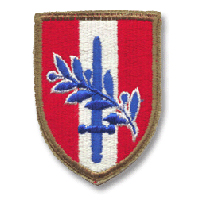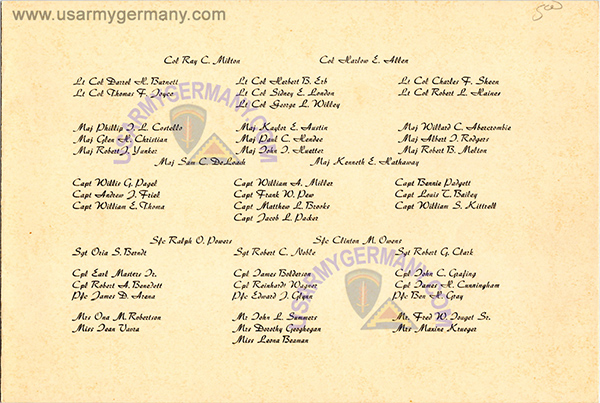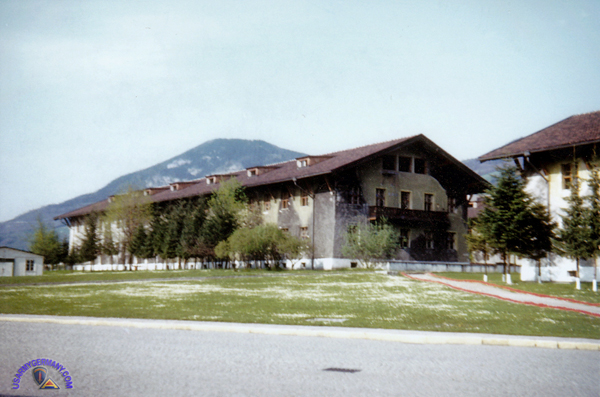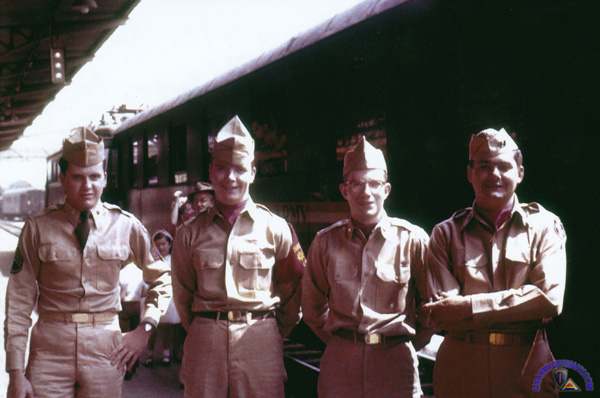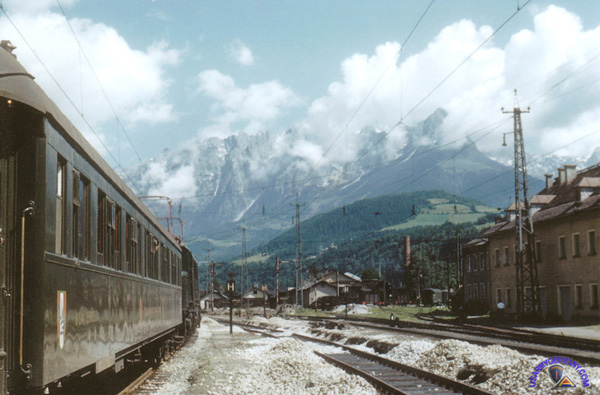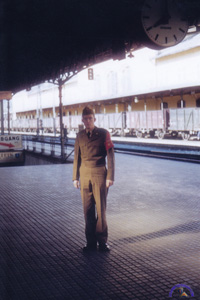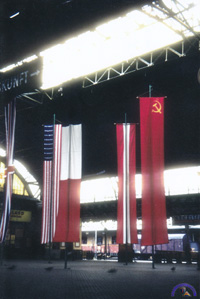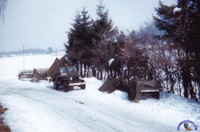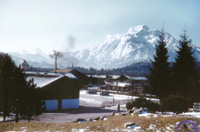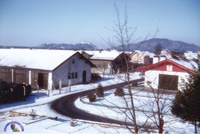| If you do
NOT see the Table of Contents frame to the left of this page, then
Click here to open 'USArmyGermany' frameset |
||||||||||||
|
Transportation Division |
||||||||||||
|
|
||||||||||||
|
||||||||||||
|
|
||||||||||||
| General Information | ||||||||||||
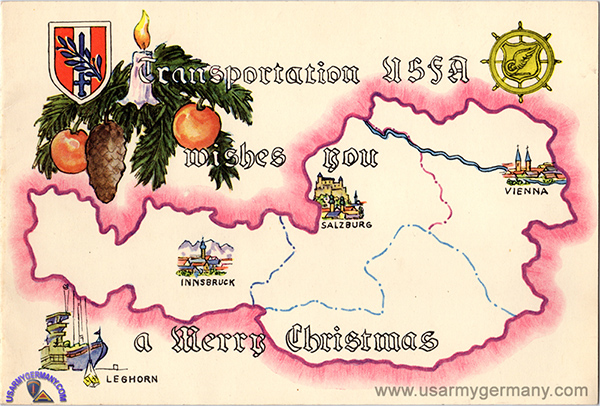 Christmas card, HQ USFA Transportation Section, 1953 (Webmaster's collection) |
||||||||||||
| 102nd Transportation Company (Movement Control) | ||||||||||||
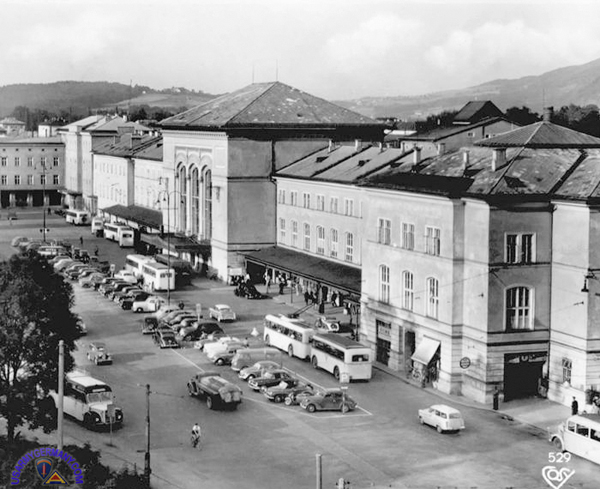 Salzburg Bahnhof, mid-1950s (Austrian postcard) |
||||||||||||
| 1955 | ||||||||||||
| (Source: Email from Don Lodge) | ||||||||||||
| I grew up in Cedar Rapids, IA. I enlisted in the Army to get some kind of training, after graduating from Coe College in June of 1954. The draft board was breathing down my neck! In fact, the day I boarded a bus for the induction center in Des Moines, I was to have reported to the local draft board. After my first nine weeks of basic training at Fort Bliss, TX, I spent my second nine at Fort Eustis, VA, studying Transportation Movement Control. Tying for top grade in our class got me an assignment in Austria rather than in South Korea or Germany, for which I was very grateful. Christmas Eve, 1954, found us leaving Camp Kilmer and being loaded on the USNS Callahan bound for Austria. That was no doubt the bleakest Christmas and New Years I ever experienced. We hit very rough seas out on the Atlantic and were glad to land in Casablanca to offload troops and supplies. We were able to get ashore and take an American Express bus tour of the city. Then we sailed on to Livorno, Italy, and were bussed to Camp Darby. It was snowy and colder there than we had expected, especially while living in walled tents. |
||||||||||||
| Loaded onto a troop train, four men to a coach compartment meant for six, with our duffle and personal effects bags was another cold and uncomfortable experience. We came over the Brenner Pass at night. The trip of 523 miles took 21 hours and 15 minutes. The motive power was electric. When we arrived in Salzburg I and several of my fellow classmates were bussed to Camp Truscott to join the 102nd Transportation Movement Control Company. Our unit controlled all rail and motor transport in Austria. Captain Lemon was our commanding officer. Camp Truscott had been built as a SS training base during the Nazi occupation. The major buildings were concrete covered in stucco and very comfortable. A young male DP handled all the cleaning, for which we each gladly paid a small fee. Our Company had an excellent mess crew and the food was quite good, especially the breads and deserts. . They used a baggage car outfitted as a field kitchen for feeding troops on the move in and out of Austria. Refugees from Glasenbach, the adjacent displaced persons camp, performed KP duty, I was assigned to the Rail Transportation Office in the Salzburg rail station. Actually I was given a choice of that or the Motor Movement Office. I choose the rail assignment because I had always had a strong interest in railroads. My buddy, Tom Barrani (sp?) chose the highway office. Barrani grew up in Hungary during the Nazi occupation. He was fluent in German. He would get very upset when we were on the town in Salzburg to hear civilian comments about us, but he never let on. He was one cool guy. Others in our company who I remember were sergeants Best, Braxton and Boysil. |
||||||||||||
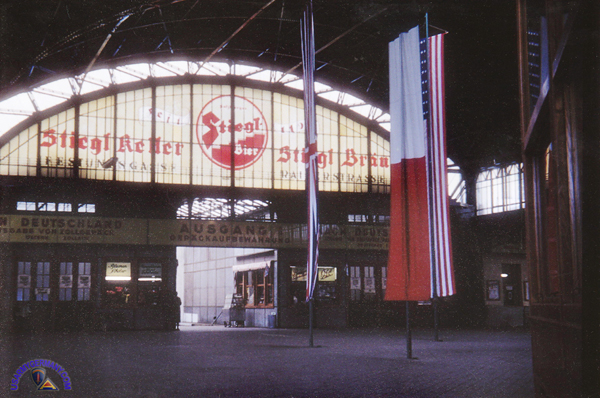 Inside the Salzburg Bahnhof - flags of the occupying powers are flown as their 10-year presence in Austria comes to an end, 1955 (more info: WIKIPEDIA) |
||||||||||||
| Captains Neely and Gergli and Sgt. Dean Rittenhouse were my superiors at the RTO. Kandel from Chicago and I were privates. Austrian civilians Vera and Alex assisted with language and other local affairs and Willy was our jeep driver. (Alex had flown a fighter with the Luftwaffe during the war). At the RTO we booked reservations on The Mozart to Vienna and the sleeping cars to Leghorn (Livorno) Italy. These were both duty trains but military personnel on leave, dependants and U.S. civilians could book either train on a space-available basis. We also assisted both GIs and US civilians with non duty-rail travel. The RTOs were connected by Teletype and after the Mozart and the Livorno Sleeper left Salzburg a message was sent containing the names of the passengers. During the week Alex or Vera would operate the telex but on weekends I had to send these messages. I typed very slowly so when I got to the end of the lists some operator elsewhere on the system would quickly type the standard ending to get me off the line. Working in the RTO during the day, we usually ate lunch at the snack bar in the Mirabelle. We got a small per diem for these meals. Sometimes I ate in the restaurant located in the Banhoff. On weekend evenings some of us would ride the military bus to the General Walker Hotel near Berchtesgaden, about 20 minutes distance. At that time all their silverware and coffee service pieces were marked with swastikas on the bottoms. Hitler’s Eagles Nest and one of the underground bunkers near by were open for tours. The Mozart duty train is covered elsewhere on this site so I will only briefly comment on it. It took four hours and 20 minutes to reach Vienna with brief stops in Wels and Linz. It left Salzburg at 10:35 A.M. and arrived in Vienna at 2:55 P. M. It left Vienna for Salzburg at 3: 45 P. M. Its 10:35 A. M. departure from Salzburg allowed passengers from the Leghorn sleeper to connect with the Mozart. By 1955 it carried but one burly MP to and from Vienna. I rode it one morning and returned the next afternoon. The non-duty round trip cost $4.30. Before crossing the border into the Russian Zone our MP would come through the train to close all the window shades. They had to remain closed until we got into the Central zone of Vienna. The evening I was there happened to be on the day the treaty with Austria went into effect and the government was handed back to the Austrians. There was no celebrating that evening in Vienna, just a solemn single-file parade of Austrians carrying lighted candles and umbrellas and walking around the Old Town in the rain. It was a very somber event. |
||||||||||||
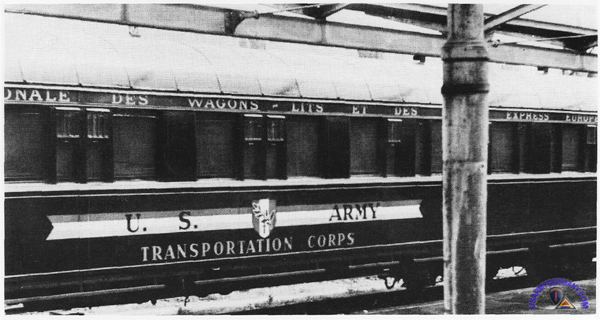 Leghorn sleeper at the Salzburg Bahnhof |
||||||||||||
| Due to a lack of sergeants in our company, I was assigned to ride the Leghorn sleeper round trip as Car Commander 20 times. I was only a private at the time. The Sleeper ran six days a week to Salzburg, Monday to Saturday, and to Livorno on Sunday though Friday. It ran from the Salzburg Bahnhoff late morning and arrived in Livorno around 8 AM the following morning. The return trip arrived back in Salzburgh at 9:50 A.M. the third day. When I arrived in Livorno I rode with the local RTO crew back to the base, had breakfast and got a shave at the PX barbershop. Later on I rode back to the railroad station to catch the northbound sleeper. The sleeping cars were Wagon-Lits sleepers that before the war had been used on the Orient Express. They carried the Wagon-Lits blue and silver scheme plus in the center of the car sides under the windows a red, white and blue band with the Austrian Command logo in the middle. The words “U.S. ARMY” flanked the logo and underneath the band were the words,” TRANSPORTATION CORPS”. Years later my wife and I rode one of these cars on the New Orient Express from Innsbruck to Venice. The Car Commander was in charge, regardless of rank. I never had any trouble with this on any of my trips, but the job didn’t require giving any orders to the passengers beyond informing them of our meal stops However the Colonel in charge of the Italian Movement Control unit was an SOB. He rode once and demanded that I get him some ice water though he knew our cars didn’t carry any. Fortunately my Austrian porter was able to get some from the dining car, even though it had already closed for the evening. With the exception of one grouch, those Austrian porters were great. On one trip we had a sergeant and his shell-shocked Austrian war bride on board. There are a number of tunnels on the route and we didn’t run the car lights in the daytime. Every time we went into a tunnel the car became dark and the women started to scream. I asked the porter to turn on the lights but he refused. Shortly after this trip I was able to get a brass Wagon-Lits key of my own so I could turn on the lights. On the southbound run we stopped in Innsbruck for close to two hours, waiting to be picked up by another train. Our cars ran on civilian trains. There were several taller buildings just south of the station. When our train pulled in there were always a number of “ladies” hanging out the windows, welcoming us. Many a GI was “entertained” during that stop. Meals could be taken on the Wagon-Lit’s dining car, but they were quite expensive. Most passengers ate during the layovers between trains. Southbound we ate in Innsbruck and in the evening of the return trip during our stop in Florence I usually picked up a box lunch from a vendor on the platform. That consisted of ravioli, a roll, a salad and a small bottle of wine, which I, a teetotaler, gave to the porter. The highest-ranking officer I ever carried was a one-star general and his aide. I was nervous about having the general on board but he asked for no special treatment. On one trip we carried the USO performer Katrina Valenti. That was her stage name, not the name on her passport. She carried a small dog with her. There was a rather obnoxiously belligerent corporal from Boston stationed at the RTO in Brenner. We came through there southbound around two or three in the morning. He expected me to be awake, fully dressed and standing at the car door when we arrived, to exchange mail and pleasantries. He thought if he had to be up at that time I should be also. I don’t think I ever did so; my Austrian sleeping car porter took care of the exchange. I never caught any flak for that from anyone except the corporal. One trip north the Livorno RTO crew placed an automobile battery into the mail compartment. It was to be dropped off at an intermediate station for some colonel but they failed to inform me about the package. At the designated station I was asked for the battery. I said that I knew nothing about it. When we arrived in Salzburg, the battery was discovered lying on its side in the compartment we used for mail, the acid all over the floor carpet. Because Livorno had failed to tell me about the battery, I never caught any flack for this either. Once the peace treaty was finalized, we were a busy lot. We were lucky if we got one day off a week from them on. We processed dependents and GIs for movement to ports and to repo depots. In checking duffle bags of the enlisted men for contraband, every so often one of our team would “accidentally” push a bag onto the floor, listening for the crash of a bottle. Sometimes contraband liquor was found in this way. I helped load the last troop train out of Austria, then removed my maroon RTO armband and became just another GI headed for the Repo Depot in Germany. At that depot I did everything but get on my knees to get a good assignment, after learning that a PFC wasn’t eligible to be assigned to a position that called for a Transportation Movement Control Specialist. He finally accepted my logic and assigned me to the RTO at the port of Liverpool, England. This meant rations-and-quarters allowances as we lived off base. The closest US base, Burtonwood AFB, being too far for a daily commute. My duty in Austria was a great experience! ADDITIONAL INFORMATION Q. Where within the Salburg Bahnhof building was the RTO located? A. Inside the large structure in the center. There were wide steps leading from the ground floor doors to the second (trackside) floor. The stairs led to a large covered plaza. To the right was the entrance to passport control for trains headed for Germany. On the left was the building that contained a restaurant. The RTO was on the far side of this building. Two tracks flanked either sides of this building with platforms serving the inner set of tracks. Q. What did the RTO consist of? A. The single room was probably about 20' by 30'. There was a ticket counter across the middle. There were 6-8 seats in the waiting area. There were fours desks along the back wall for the secretary, liaison, sergeant and one of the captains. There was no baggage service on the Sleeper or the Mozart. Q. How many personnel were assigned to the RTO? Did you work in shifts? A. Two Captains, one sergeant and three privates, plus an Austrian driver, a secretary and a liaison with the Austrian railroad. We were open from 8 to 5 seven days a week. We all worked five days a week and alternated working on weekends. After the treaty was signed we had very few days off. Q. Did any duty trains arrive from Munich to then connect with the Mozart? A. No. The Mozart had run from Berlin through Munich to Salzburg and Vienna but the Berlin to Salzburg portion was discontinued before I arrived. Q. Did all duty travel to Italy (Verona, Vicenza and Leghorn) originate from Salzburg or were there sleepers that came from Linz and/or Vienna with the Mozart that then were attached to the trains originating from Salzburg? Basically, if one traveled from Vienna or Linz to Italy did they have to switch trains at Salzburg? A. Yes, all traffic to Italy originated in Salzburg. The Sleeper did not serve Venice. Q. I assume anyone wanting to go to Berchtesgaden from Vienna or Italy got off at Salzburg and took a bus to the recreation area? Or was there a special US train to Berchtesgaden? A. Military buses ran to B’gaden every hour; perhaps more frequently. They left from the Mirabelle. It was only about a twenty minute ride. |
||||||||||||
|
||||||||||||
| 440th Transportation Light Truck Company | ||||||||||||
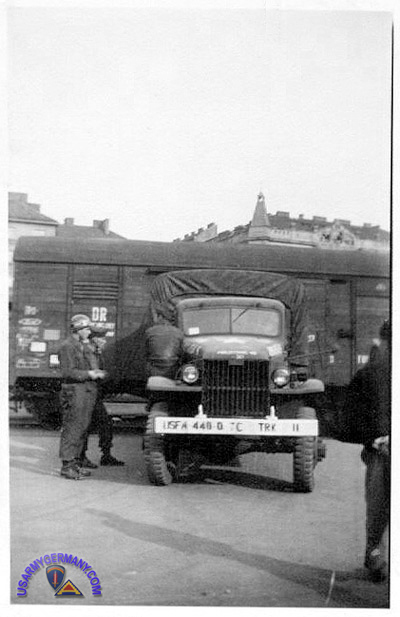 A truck from the 440th QM Truck Co at the Westbahnhof in Vienna, 1946 |
||||||||||||
| (Source: STARS & STRIPES, Sept 11, 1954) | ||||||||||||
| The 440th Transportation Company (Lt Trk) located at Salzburg hauls everything from soldiers to milk bottles in support of US Forces in Austria. Under the command of Capt Robert F. Wanek, the company provides truck transportation for USFA maneuvers; hauls equipment anywhere from Trieste to Munich; moves dependent family furniture; and performs all the functions of a commercial freighting outfit for military personnel in USFA. The company is equipped with 68 (?) 2½-ton trucks, five ¼-ton trucks, and a five-ton wrecker. In addition to the afore-mentioned duties, the company also runs driving schools for bus operators and truck drivers and also gives courses in maintenance to its own personnel as well as to soldiers from other outfits. |
||||||||||||
| Related Links: |
||||||||||||
